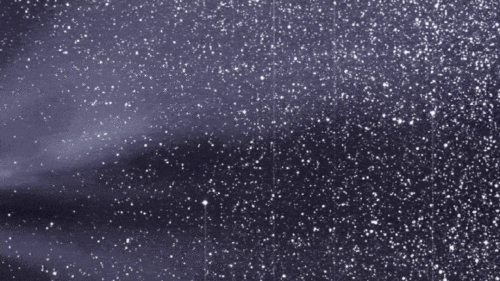The Solar Orbiter spacecraft, which is in the run-up phase, happened to cross the comet's tail and its operators were able to take advantage of this to study it using some of the instruments * This is the first time that an encounter between a comet's tail and a spacecraft that was not designed to pursue it was predicted in advance * Another spacecraft - STEREO-A remotely photographed the comet crossing its field her sight
From: NASA Goddard Space Flight Center. Translation: Ziv Adaki

The STEREO-A (Solar Terrestrial Relations Observatory) space telescope captured these images of Comet Atlas as it passed near the Sun from May 25 to June 1. During the observations and out of STEREO-A's field of view, the Solar Orbiter spacecraft of NASA and the European Space Agency crossed one of the two tails of the comet.
In the animated image, Atlas emerges from above and moves towards the sun - out of the camera lens on the left - against gusts of solar wind. The dust tail of the comet, in which sunlight is reflected, appears white. The planet Mercury is also visible, emerging as a bright point to the left within the stationary star field. The vertical lines in the picture are the product of connecting bright stars in the background.
While STEREO-A was shooting this video clip, the Solar Orbiter spacecraft crossed one of Atlas' tails. The spacecraft, which was launched in February 2020, was not supposed to begin full research activity until June 15, but engineers changed the schedule and activated its four most relevant instruments in preparation for the rendezvous. This is the first time such an encounter has been predicted, between a comet's tail and a spacecraft that was not designed to chase it.
The two tails left behind by a comet are the result of material falling from its nucleus: a thin ion tail, composed of charged particles, and a more diffuse dust particle tail, in which visible light is reflected. The dove's tail always points away from the sun, regardless of the comet's orbit; The dust tail follows more closely the comet's orbit. The Solar Orbiter spacecraft crossed the dovetail of Atlas on May 31, about 43 million km downstream and out of STEREO-A's field of view. The team is still waiting for these results. The spacecraft flew through the remnants of the Atlas dust tail on June 6.
The comet Atlas was discovered on December 28, 2019 in photographs taken by the Asteroid Terrestrial-impact Last Alert System, or the automatic astronomical research system for locating objects that may harm the Earth or in English for its initials - Atlas, in Hawaii. And according to tradition, the comet is named after the device or the person who discovered it. Atlas moved in a path that led it to pass the surface of the sun approximately every 6,000 years, from the observations it appears that Atlas is now disintegrating and is unlikely to return again. It most likely originates from the Oort Cloud, a cloud of ice and rocks that surrounds our solar system. The Oort cloud starts at a distance of about 300 billion km, about 70 times the distance to the planet Rahab (Neptune), currently the most distant official planet in the solar system.
More of the topic in Hayadan:
The Solar Orbiter spacecraft was launched to circle the Sun to observe the poles
